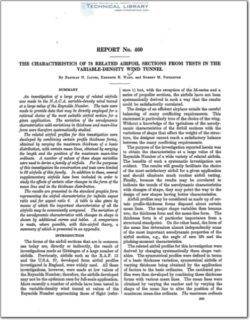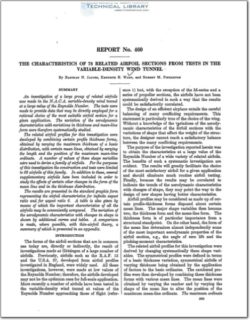naca-report-460

- Version
- 675 Downloads
- 4.69 MB File Size
- 1 File Count
- April 23, 2016 Create Date
- April 23, 2016 Last Updated
National Advisory Committee for Aeronautics, Report - The Characteristics of 78 Related Airfoil Sections from tests in the Variable Density Wind Tunnel

An investigation of a large group of related airfoils
was made in the N.A.C’.A. variable-density wind tunnel
at a large value of the Reynolds Number. The tests were
made to provide data that may be directly employed for a
rational choice of the most suitable airfoil section for a
given application. The variation of the aerodynamic
characteristics with variations in thickness and mean-line
form were therefore systematically studied.
The related airfoil profiles for this investigation were
developed by combining certain profile thickness forms,
obtained by varying the maximum thickness of a basic
distribution, with certain mean lines, obtained by varying
the length and the position of the maximum mean-line
ordinate. A number of values of these shape variables
were used to derive a family of ailjoils. For the purposes
of this investigation the construction and tests were limited
to 68 airj'oils of this family. In addition to these, several
supplementary airfm'ls have been included in order to
study the ejects of certain other changes in the form of the
mean line and in the thickness distribution.
The results are presented in the standard graphic form
representing the airfoil characteristics for infinite aspect
ratio and for aspect ratio 6. A table is also given by
means of which the important characteristics of all the
airfoils may be conveniently compared. The variation of
the aerodynamic characteristics with changes in shape is
shown by additional curves and tables. A comparison
is made, where possible, with thin-airfoil theory, a
summary of which is presented in an appendix.
The forms of the airfoil sections that are in common
use today are, directly or indirectly, the result of
investigations made at Gettingen of a large number of
airfoils. Previously, airfoils such as the RAF. 15
and the USA. 27, developed from airfoil profiles
investigated in England, were widely used. All these
investigations, however, were made at low values of
the Reynolds Number; therefore, the airfoils developed
may not be the optirfium ones for full-scale application.
| File | Action |
|---|---|
| naca-report-460 The Characteristics of 78 Related Airfoil Sections from tests in the Variable Density Wind Tunnel.pdf | Download |
Comment On This Post